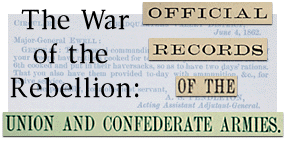Summary:
Union General Phillip Sheridan writes General Grant to discuss the August, 1864,
strategic situation in the Shenandoah Valley. Sheridan mentions that he has
destroyed crops in the Valley south of Winchester forcing Confederates to haul
supplies from the Staunton area.
Lieut.-Gen. GRANT:
CHARLESTOWN,
August 19, 1864
All the information received to-day shows a large concentration of the enemy at Winchester. I receive constant reports of the passage of troops across to this Valley from Culpeper. I have taken the defensive until their strength is more fully developed. They have made no attempt to pass down the Valley to Martinsburg, which I hold with a small force of cavalry. If they cross the Potomac they expose their rear and I will pitch into them. I destroyed everything that was eatable south of Winchester, and they will have to haul supplies from well up toward Staunton. Our loss at Winchester will be about 200. Guerrillas give me great annoyance, but I am quietly disposing of numbers of them. The enemy appears to be uncertain as to what course to pursue. The intention so far as I can learn was to send a column direct from Culpeper to the Potomac and Early to advance at the same time from Martinsburg. This was frustrated by Early being compelled to fall back and your operations on the north side of the James. I still think that two divisions of infantry have come here and Fitz Lee's cavalry. My force will have to be weakened to supply the place of the 100-days' men serving at Harper's Ferry and in West Virginia. Grover has joined me. I now can calculate on bringing into action about 22,000 or 23,000 infantry and about 8,000 cavalry.
Respectfully,
P. H. SHERIDAN,
Maj.-Gen.
Bibliographic Information : Letter Reproduced from The War of The Rebellion: Official Records of the Union and Confederate Armies, Series 1, Volume 43, Serial No. 90, Pages 841, Broadfoot Publishing Company, Wilmington, NC, 1997.

